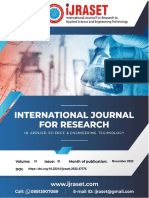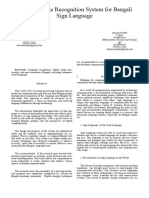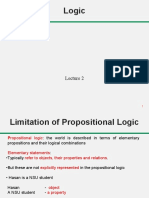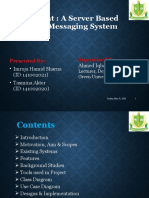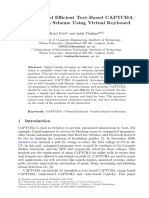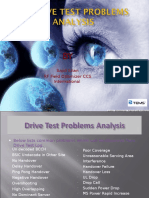Development of A Tangent Based Robust Speech Feature Extraction Model
Development of A Tangent Based Robust Speech Feature Extraction Model
Uploaded by
Ahmed IqbalCopyright:
Available Formats
Development of A Tangent Based Robust Speech Feature Extraction Model
Development of A Tangent Based Robust Speech Feature Extraction Model
Uploaded by
Ahmed IqbalOriginal Description:
Original Title
Copyright
Available Formats
Share this document
Did you find this document useful?
Is this content inappropriate?
Copyright:
Available Formats
Development of A Tangent Based Robust Speech Feature Extraction Model
Development of A Tangent Based Robust Speech Feature Extraction Model
Uploaded by
Ahmed IqbalCopyright:
Available Formats
Development of a Tangent Based Robust Speech
Feature Extraction Model?
Mohammad Tareq Hosain1 , Abdullah Al Arif2 , Ahmed Iqbal Pritom3 , Md
Rashedur Rahman4 , and Md. Zahidul Islam5
1
Department of CSE, Green University of Bangladesh, Dhaka, Bangladesh
mtareqhosain@gmail.com
2
Department of CSE, Green University of Bangladesh, Dhaka, Bangladesh
arif.cse.gub@gmail.com
3
Department of CSE, Green University of Bangladesh, Dhaka, Bangladesh
iqbal@cse.green.edu.bd
4
Department of CSE, Islamic University of Technology, Gazipur, Bangladesh
bishad19@iut-dhaka.edu
5
Department of CSE, Green University of Bangladesh, Dhaka, Bangladesh
zahid@cse.green.edu.bd
Abstract. An accurate speech recognition system requires close obser-
vation of the selection of an error-free speech feature extraction model.
This paper describes a prominent solution to obtain robust features from
the sound spectrum and ensures the easy recognition of speech. The pro-
posed architecture uses Tangent based (TB) auditory feature extraction
that aims to find and process robust features from the sine wave of audi-
tory signal data. This experiment suggests that every specific tune carries
distinguishing signal patterns in the spectrum diagram and hence does
the tangent of the amplitude of the same signal. To recognize the sound,
a single attribute had been used rather than using multiple attributes
where the slope of the sound spectrum being calculated.
Keywords: Tangent Based (TB) Feature Extraction · Sound Spectrum
· Signal Processing · Speech Recognition
1 Introduction
Humans have an unparalleled physical ability to be engaged in sophisticated
vocal communication. Our vocal folds, combined with the articulators, produces
a perplexing arrangement of the tune, namely “Speech”, which can be considered
as information if interpreted correctly. The speech production process includes
vent, voice and elocution [1]. Undoubtedly, speech is the most contributing factor
in linguistic messaging. It should be noted that the ingenuousness with which
humans speak is in contrast to the complication of the process.
Voice spectrogram, commonly known as voiceprint is a sophisticated way to
display speech signal which can differ by a wide margin due to different attitude
?
Supported by Green University of Bangladesh
You might also like
- U170 Yr7 ES Leaflet PDFDocument36 pagesU170 Yr7 ES Leaflet PDFAFuentesCaballero60% (5)
- Linear Algebra Cheat SheetDocument2 pagesLinear Algebra Cheat SheetNooraniManshadNo ratings yet
- D3223.22337 - Standard Test Method For Total Mercury in WaterDocument8 pagesD3223.22337 - Standard Test Method For Total Mercury in WaterIngrid Mora100% (1)
- Lit Rev Dis 1Document24 pagesLit Rev Dis 1313 afsal tsNo ratings yet
- Deep Learning Based Multilingual Speech Synthesis Using Multi Feature Fusion MethodsDocument16 pagesDeep Learning Based Multilingual Speech Synthesis Using Multi Feature Fusion Methodszerihun nanaNo ratings yet
- Survey of Deep Learning Paradigms For Speech ProcessingDocument37 pagesSurvey of Deep Learning Paradigms For Speech ProcessingsoumikfarhanNo ratings yet
- V4I4-1307 UuuDocument6 pagesV4I4-1307 Uuu27Niharika DVNo ratings yet
- 10 - Recurrent Neural Network Based Speech EmotionDocument13 pages10 - Recurrent Neural Network Based Speech EmotionAlex HAlesNo ratings yet
- Comparative Analysis of Automatic Speech Recognition TechniquesDocument8 pagesComparative Analysis of Automatic Speech Recognition TechniquesAbdelkbir WsNo ratings yet
- Punjabi ADocument7 pagesPunjabi AKaran GillNo ratings yet
- Dialect Recognition System For Bagri Rajasthani Language Using Optimized Featured Swarm Convolutional Neural Network (Ofscnn) ModelDocument20 pagesDialect Recognition System For Bagri Rajasthani Language Using Optimized Featured Swarm Convolutional Neural Network (Ofscnn) Modelindex PubNo ratings yet
- s11277 024 11448 XDocument35 pagess11277 024 11448 Xsmahadev88No ratings yet
- Development of Multilingual SpeechDocument13 pagesDevelopment of Multilingual Speechariaandrosss68No ratings yet
- Devi Priya SECOND PAPERDocument7 pagesDevi Priya SECOND PAPERNaga Raju GNo ratings yet
- Applsci 13 05389Document2 pagesApplsci 13 05389issacNo ratings yet
- 103 359 1 PBDocument6 pages103 359 1 PBRaymond ThemiNo ratings yet
- Speech To TextDocument6 pagesSpeech To TextTint Swe OoNo ratings yet
- 1 s2.0 S0952197616302391 MainDocument8 pages1 s2.0 S0952197616302391 MainRaviShankar PrasadNo ratings yet
- OromignaDocument19 pagesOromignazerihun nanaNo ratings yet
- Pronunciation Tutor For Deaf Children Based On ASRDocument6 pagesPronunciation Tutor For Deaf Children Based On ASRsjzcvw27j4No ratings yet
- Applsci 13 00469 v3Document19 pagesApplsci 13 00469 v3RiZhe JinNo ratings yet
- 7th Sem Report Sign Language RecognitionDocument15 pages7th Sem Report Sign Language Recognitiontejasbangre200No ratings yet
- Voice Recognition System: Speech-To-Text: Journal of Applied and Fundamental Sciences November 2015Document6 pagesVoice Recognition System: Speech-To-Text: Journal of Applied and Fundamental Sciences November 2015Subramani VNo ratings yet
- Voice Recognition System: Speech-To-Text: Journal of Applied and Fundamental Sciences November 2015Document6 pagesVoice Recognition System: Speech-To-Text: Journal of Applied and Fundamental Sciences November 2015Subramani VNo ratings yet
- v1 CoveredDocument32 pagesv1 Coveredmrunal shethiyaNo ratings yet
- Removal of Spectral Discontinuity in ConcatenatedSpeech WaveformDocument5 pagesRemoval of Spectral Discontinuity in ConcatenatedSpeech WaveformJitendra DhimanNo ratings yet
- Fast Speaker Identification Using Recursive Word Sample AttributesDocument7 pagesFast Speaker Identification Using Recursive Word Sample AttributesainalapremkumarNo ratings yet
- Meeting Insights Summarisation Using Speech RecognitionDocument8 pagesMeeting Insights Summarisation Using Speech RecognitionInternational Journal of Innovative Science and Research TechnologyNo ratings yet
- Speech Recognition Using Deep Learning TechniquesDocument5 pagesSpeech Recognition Using Deep Learning TechniquesIJRASETPublicationsNo ratings yet
- Language Detection For Global CommunicationDocument10 pagesLanguage Detection For Global CommunicationJhonny LalNo ratings yet
- An Automated Speech Recognition and Feature Selection Approach Based On Improved Northern Goshawk OptimizationDocument9 pagesAn Automated Speech Recognition and Feature Selection Approach Based On Improved Northern Goshawk OptimizationIAES IJAINo ratings yet
- JETIR2406A38Document6 pagesJETIR2406A38poojamanoharan750No ratings yet
- Assamese Dialect Identification System Using DeepDocument15 pagesAssamese Dialect Identification System Using DeepAnwesha PhukanNo ratings yet
- Deep Representation Learning in Speech Processing Challenges, Recent Advances, and Future TrendsDocument25 pagesDeep Representation Learning in Speech Processing Challenges, Recent Advances, and Future TrendsAndres CalvoNo ratings yet
- Sign Language Recognition System Using Machine LearningDocument6 pagesSign Language Recognition System Using Machine LearningIJRASETPublicationsNo ratings yet
- An_20Advanced_20NLP_20Framework_20-Formatted_20Paper-libreDocument12 pagesAn_20Advanced_20NLP_20Framework_20-Formatted_20Paper-libreLanaya WizNo ratings yet
- Effect of Singular Value Decomposition Based Processing On Speech PerceptionDocument8 pagesEffect of Singular Value Decomposition Based Processing On Speech PerceptionDarrenNo ratings yet
- Effect of Singular Value Decomposition Based Processing On Speech PerceptionDocument8 pagesEffect of Singular Value Decomposition Based Processing On Speech PerceptionDarrenNo ratings yet
- Final Paper IEEEDocument4 pagesFinal Paper IEEESaniul Islam SaniNo ratings yet
- Spectral Feature Based Automatic Tonal and Non-Tonal Language ClassificationDocument7 pagesSpectral Feature Based Automatic Tonal and Non-Tonal Language ClassificationAlice Celin AlphonsaNo ratings yet
- Review of Feature Extraction Techniques in Automatic Speech RecognitionDocument6 pagesReview of Feature Extraction Techniques in Automatic Speech RecognitionFréjusf Laleye100% (1)
- Voice Recognition System Speech To TextDocument5 pagesVoice Recognition System Speech To TextIbrahim LukmanNo ratings yet
- FypDocument18 pagesFypangellara.al82No ratings yet
- Base PaperDocument10 pagesBase PaperCYRUS EDWINSON 21ITR008No ratings yet
- Audio To Indian Sign Language TranslatorDocument6 pagesAudio To Indian Sign Language TranslatorIJRASETPublicationsNo ratings yet
- (7-14) Journal of Soft Computing and Computational Intelligence5Document8 pages(7-14) Journal of Soft Computing and Computational Intelligence51DT20IS052 MANISHNo ratings yet
- Chapter-3: Theory of TTSDocument26 pagesChapter-3: Theory of TTSBoby JosephNo ratings yet
- Preprints202306 0223 v1Document20 pagesPreprints202306 0223 v1sansri2609No ratings yet
- RA2111003010551 and RA2111003010555Document8 pagesRA2111003010551 and RA2111003010555sanskar patilNo ratings yet
- JPNR 2022 S01 126Document8 pagesJPNR 2022 S01 126adddataNo ratings yet
- Research Paper On Speech Emotion Recogtion SystemDocument9 pagesResearch Paper On Speech Emotion Recogtion SystemGayathri ShivaNo ratings yet
- Acoustic Modeling Based On Deep Learning For Low-RDocument17 pagesAcoustic Modeling Based On Deep Learning For Low-RSumeya HusseinNo ratings yet
- Application of Speech Processing For Pathological Voice Detection and AnalysisDocument9 pagesApplication of Speech Processing For Pathological Voice Detection and AnalysisInternational Journal of Innovative Science and Research TechnologyNo ratings yet
- An Overview of Deep-Learning-Based Audio-Visual Speech Enhancement and SeparationDocument29 pagesAn Overview of Deep-Learning-Based Audio-Visual Speech Enhancement and SeparationharshrajshsNo ratings yet
- Real Time Indian Sign Language Recognition and Speech Generation Using Convolutional Neural NetworkDocument4 pagesReal Time Indian Sign Language Recognition and Speech Generation Using Convolutional Neural Networktejasbangre200No ratings yet
- 2211.09536v3Document8 pages2211.09536v3Vishal BokhareNo ratings yet
- AUDIO TO SIGN LANGUAGE Final Fishries++ (2621+to+2630)Document10 pagesAUDIO TO SIGN LANGUAGE Final Fishries++ (2621+to+2630)fena3301No ratings yet
- Full Single-Type Deep Learning Models With Multihead Attention For Speech EnhancementDocument3 pagesFull Single-Type Deep Learning Models With Multihead Attention For Speech EnhancementedramonhNo ratings yet
- (IJCST-V11I2P2) :pooja Shirude, Mohit Chaudhari, Gaurav Baviskar, Mahesh KanhereDocument3 pages(IJCST-V11I2P2) :pooja Shirude, Mohit Chaudhari, Gaurav Baviskar, Mahesh KanhereEighthSenseGroupNo ratings yet
- Development and Suitability of Indian Languages Speech Database For Building Watson Based ASR SystemDocument7 pagesDevelopment and Suitability of Indian Languages Speech Database For Building Watson Based ASR SystemleenaNo ratings yet
- Robust Processing of Spoken Situated Dialogue: A Study in Human-Robot InteractionFrom EverandRobust Processing of Spoken Situated Dialogue: A Study in Human-Robot InteractionNo ratings yet
- Neural Modeling of Speech Processing and Speech Learning: An IntroductionFrom EverandNeural Modeling of Speech Processing and Speech Learning: An IntroductionNo ratings yet
- Turkish Natural Language ProcessingFrom EverandTurkish Natural Language ProcessingKemal OflazerNo ratings yet
- A Healthcare Monitoring System Using Random Forest & IOT (MTAP)Document12 pagesA Healthcare Monitoring System Using Random Forest & IOT (MTAP)Ahmed IqbalNo ratings yet
- CSE 105: Discrete MathematicsDocument42 pagesCSE 105: Discrete MathematicsAhmed IqbalNo ratings yet
- CBC_FINALDocument1 pageCBC_FINALAhmed IqbalNo ratings yet
- Lecture 3-4Document28 pagesLecture 3-4Ahmed IqbalNo ratings yet
- Predicting Breast Cancer Recurrence Using Effective Classification and Feature Selection TechniqueDocument1 pagePredicting Breast Cancer Recurrence Using Effective Classification and Feature Selection TechniqueAhmed IqbalNo ratings yet
- Basic Discrete StructureDocument57 pagesBasic Discrete StructureAhmed Iqbal100% (1)
- AR Basketball: Consolidating Fingerstroke-Level Model For A Visuo-Haptic Augmented Reality Based Smartphone ApplicationDocument1 pageAR Basketball: Consolidating Fingerstroke-Level Model For A Visuo-Haptic Augmented Reality Based Smartphone ApplicationAhmed IqbalNo ratings yet
- TYPEHEX Keyboard: A Virtual Keyboard For Faster Typing in SmartphoneDocument1 pageTYPEHEX Keyboard: A Virtual Keyboard For Faster Typing in SmartphoneAhmed IqbalNo ratings yet
- A Combined Linguistic-Movement Model Based Bengali Text Entry Method For Physically Handicapped PeopleDocument1 pageA Combined Linguistic-Movement Model Based Bengali Text Entry Method For Physically Handicapped PeopleAhmed IqbalNo ratings yet
- Dyslexia Website UI: Tabassum Mustary Fariha Tanvir Ahammed Green University of BangladeshDocument6 pagesDyslexia Website UI: Tabassum Mustary Fariha Tanvir Ahammed Green University of BangladeshAhmed IqbalNo ratings yet
- Vocabulary Builder: A Customized Personal Vocabulary Notebook ApplicationDocument16 pagesVocabulary Builder: A Customized Personal Vocabulary Notebook ApplicationAhmed IqbalNo ratings yet
- Easy Chat: A Server Based Instant Messaging System: Presented By: Supervised byDocument21 pagesEasy Chat: A Server Based Instant Messaging System: Presented By: Supervised byAhmed IqbalNo ratings yet
- Freshers Orientation Plan Fall 2019Document2 pagesFreshers Orientation Plan Fall 2019Ahmed IqbalNo ratings yet
- Captcha SpringerDocument6 pagesCaptcha SpringerAhmed IqbalNo ratings yet
- 1302 Syllabus-Fall15Document7 pages1302 Syllabus-Fall15api-302625206No ratings yet
- Task Force StructureDocument14 pagesTask Force StructureAlex B. MolinaNo ratings yet
- Management Controls and Strategic Performance Measurement STRATEGIC Invesment Units and Transfer PricingDocument97 pagesManagement Controls and Strategic Performance Measurement STRATEGIC Invesment Units and Transfer Pricingspongebob SquarepantsNo ratings yet
- Suhani MittalDocument1 pageSuhani MittalAmit SinghNo ratings yet
- Implementing ADM1 For Plant-Wide Benchmark Simulations in Matlab/SimulinkDocument9 pagesImplementing ADM1 For Plant-Wide Benchmark Simulations in Matlab/SimulinkOmar AlmonteNo ratings yet
- Biomedical Waste Management - A Review: P. V. Deshmukh R. H. RathodDocument5 pagesBiomedical Waste Management - A Review: P. V. Deshmukh R. H. RathodEditor IJRITCCNo ratings yet
- MCNHS Handbook - New Final For Sir VengieDocument40 pagesMCNHS Handbook - New Final For Sir VengieVengie MejosNo ratings yet
- جبر الزمرDocument8 pagesجبر الزمرSadon B AsyNo ratings yet
- The Way To Eternal LifeDocument5 pagesThe Way To Eternal LifeDennis CharlesNo ratings yet
- Downstream Process For CrystallizationDocument7 pagesDownstream Process For CrystallizationSaravanakumar BagavthyNo ratings yet
- SR7 JSCFE Regulations - UrologyDocument1 pageSR7 JSCFE Regulations - Urologycontrol the chaosNo ratings yet
- Edward John Miranda Resume 2012Document3 pagesEdward John Miranda Resume 2012Ry H. LopezNo ratings yet
- Students Anxiety in Speaking English in PublicDocument14 pagesStudents Anxiety in Speaking English in PublicAsria100% (1)
- PT. METAKOM CPRANATA Mechanical Electrical Engineers 416805906.xls/ELEKTRONIKDocument2 pagesPT. METAKOM CPRANATA Mechanical Electrical Engineers 416805906.xls/ELEKTRONIKDani AhmadNo ratings yet
- MCQs Communication TheoryDocument16 pagesMCQs Communication TheoryAli ShamkiNo ratings yet
- Effectiveness of Distance Learning in Teaching Computer ProgrammingDocument8 pagesEffectiveness of Distance Learning in Teaching Computer ProgrammingJOHN ACE MARAVILLANo ratings yet
- Resume Screening Using Machine LearningDocument7 pagesResume Screening Using Machine Learningjessen.535220023No ratings yet
- Analisis Pengaruh Influencer Marketing Dan PerceivDocument6 pagesAnalisis Pengaruh Influencer Marketing Dan PerceivPutri SalbiahNo ratings yet
- Structural Integrity Test (Schmidt Hammer) - FadeyiDocument16 pagesStructural Integrity Test (Schmidt Hammer) - FadeyiBukayoNo ratings yet
- Digitally Programmable AmplifierDocument7 pagesDigitally Programmable AmplifierDRAGAN ANDRICNo ratings yet
- NELC Learning Resource No.7Document70 pagesNELC Learning Resource No.7marylove llubitNo ratings yet
- Charles Steinmetz Letter Book 17 December 1913 May 1914Document17 pagesCharles Steinmetz Letter Book 17 December 1913 May 1914NarasimNo ratings yet
- Churches of PalestineDocument11 pagesChurches of PalestineGheorghe AndreeaNo ratings yet
- Carlos L. Albert High School: LITERATURE REVIEW Online Game AddictionDocument5 pagesCarlos L. Albert High School: LITERATURE REVIEW Online Game AddictionNeo Jhene Ann RafolNo ratings yet
- Saxofon en AlemaniaDocument132 pagesSaxofon en AlemaniaLaura PinnaNo ratings yet
- Sajid Khan RF Field Optimizer CCS InternationalDocument38 pagesSajid Khan RF Field Optimizer CCS InternationalFakhar Muhammad Hussain NaqviNo ratings yet
- Step and Touch Voltage Update For 2004 090804Document23 pagesStep and Touch Voltage Update For 2004 090804Tamador HammashNo ratings yet


































